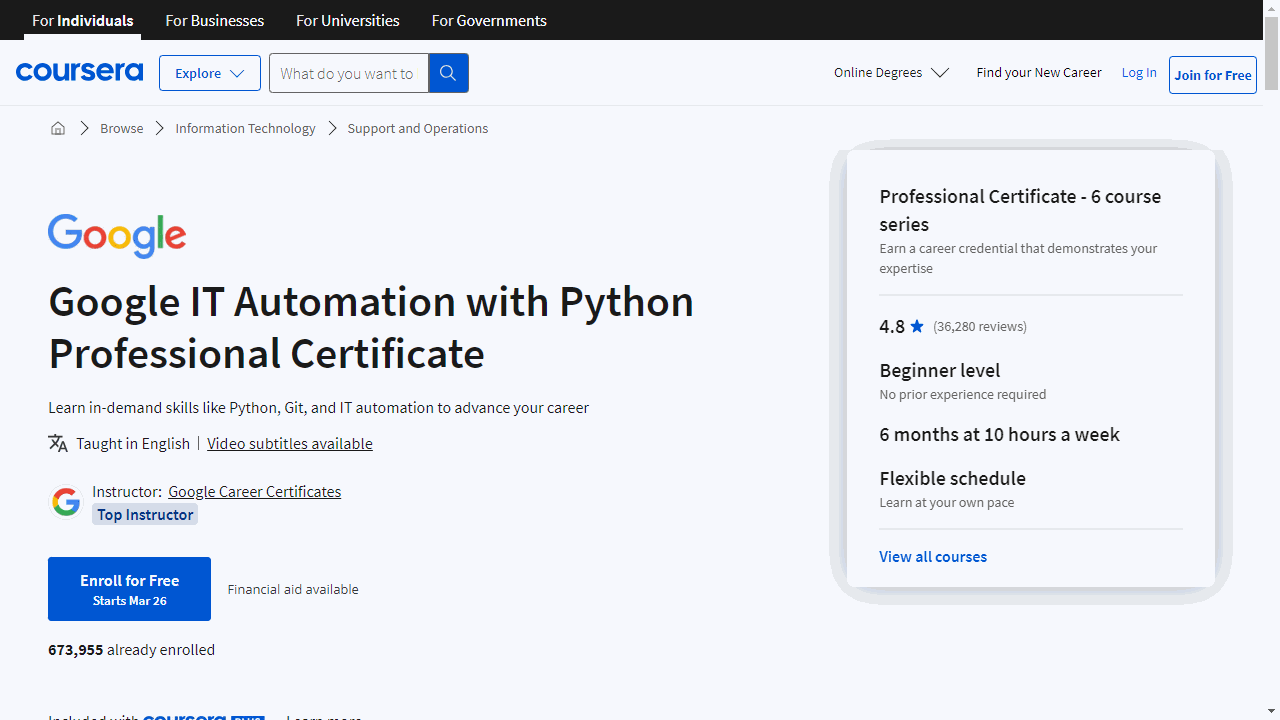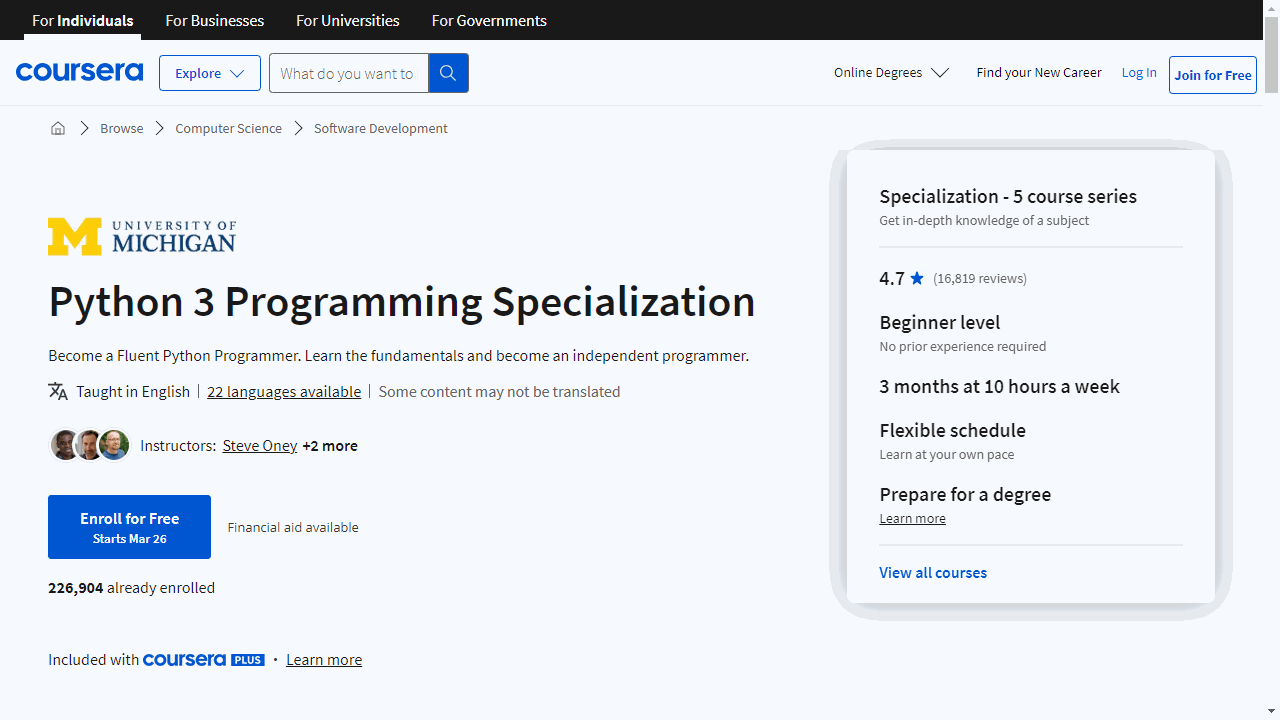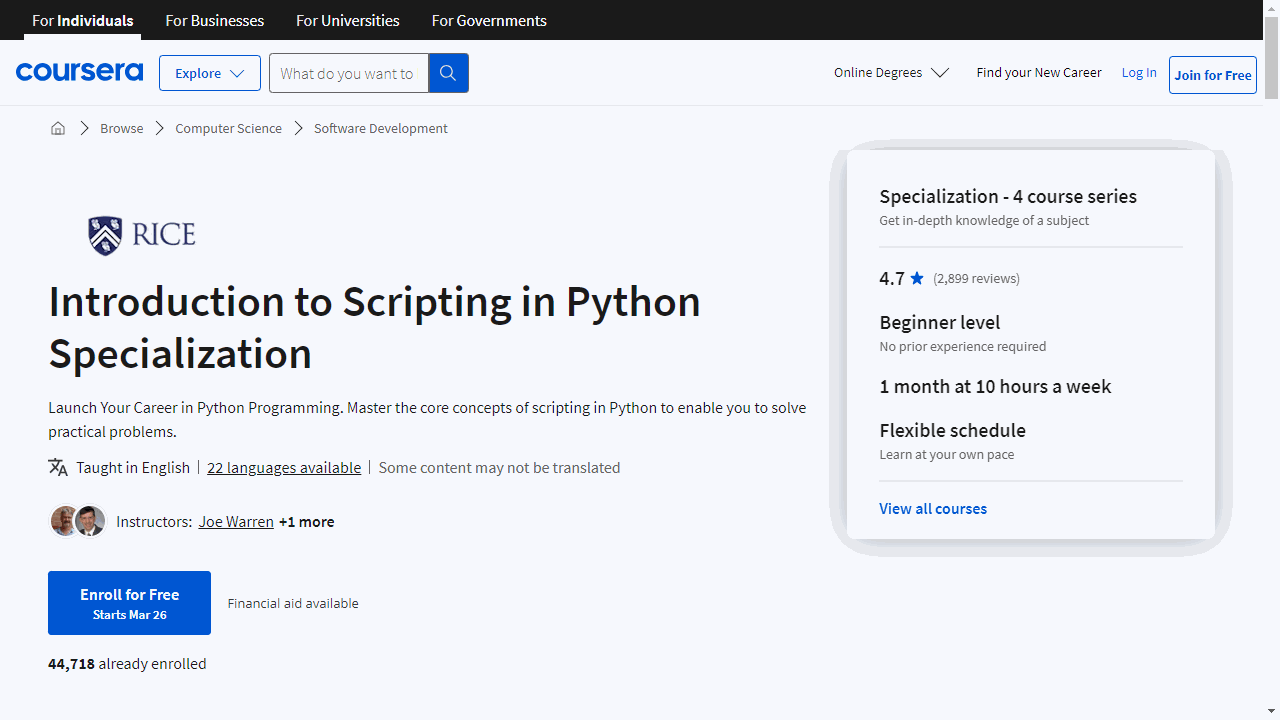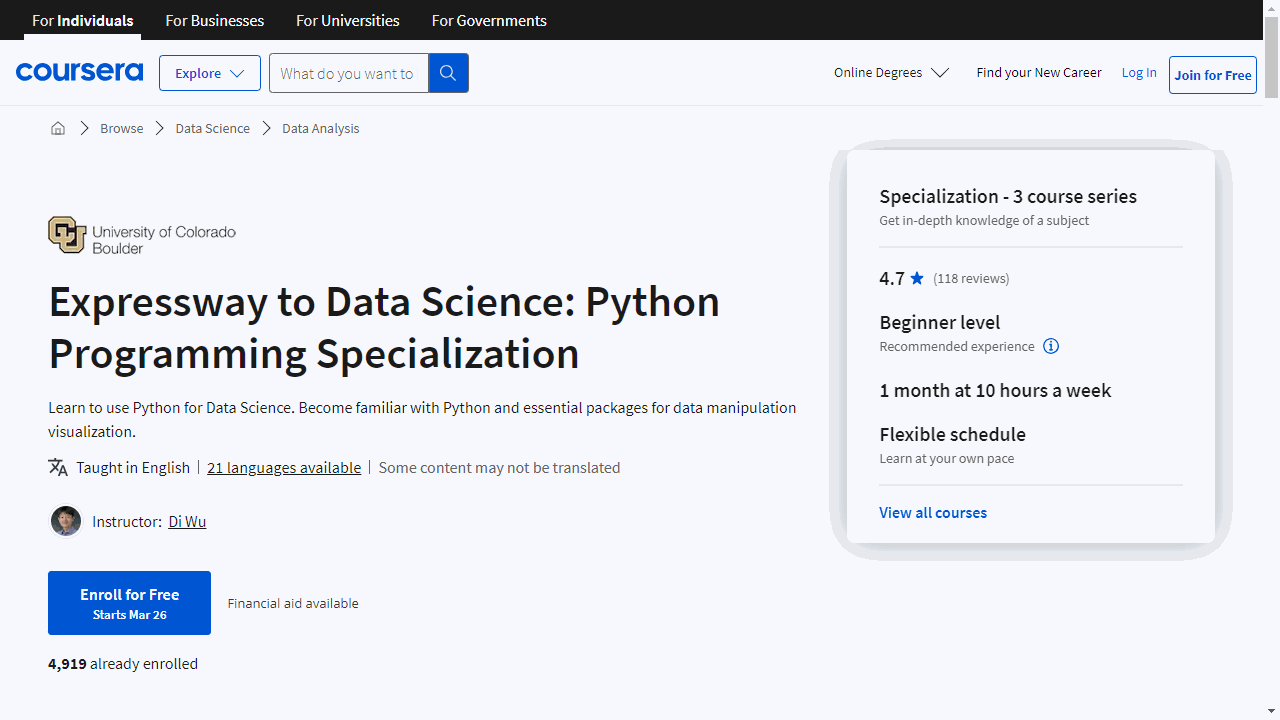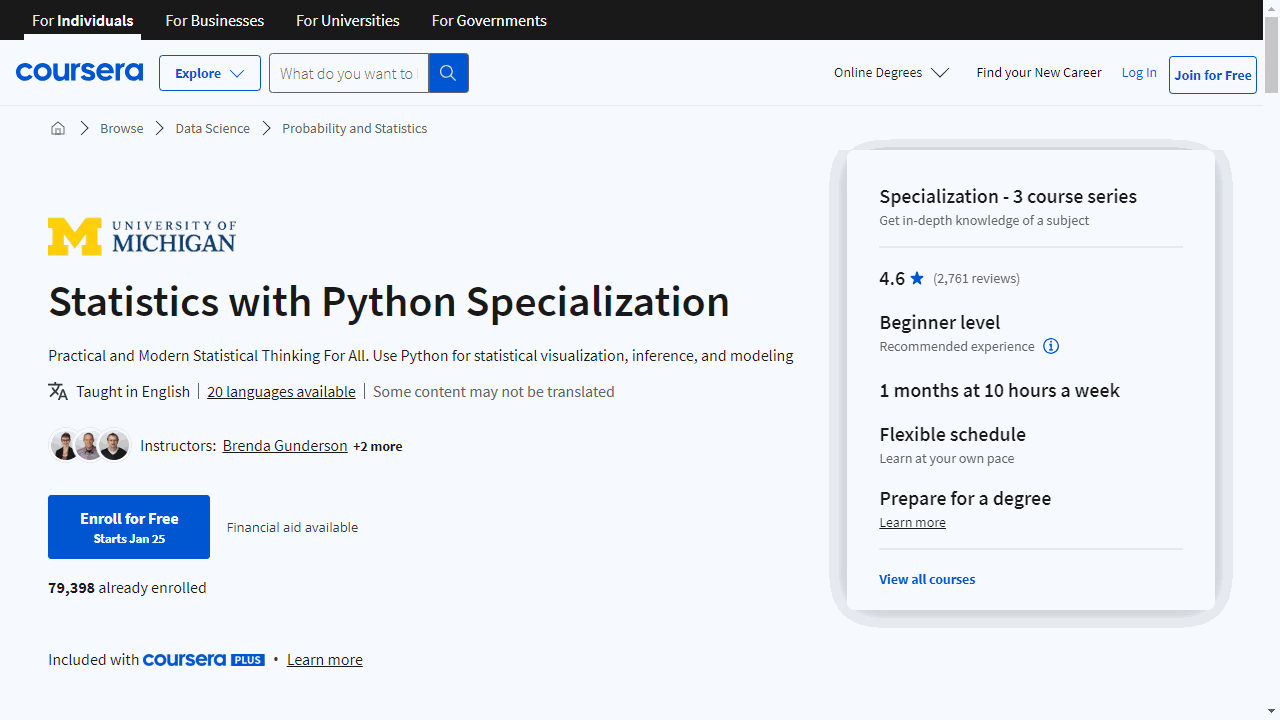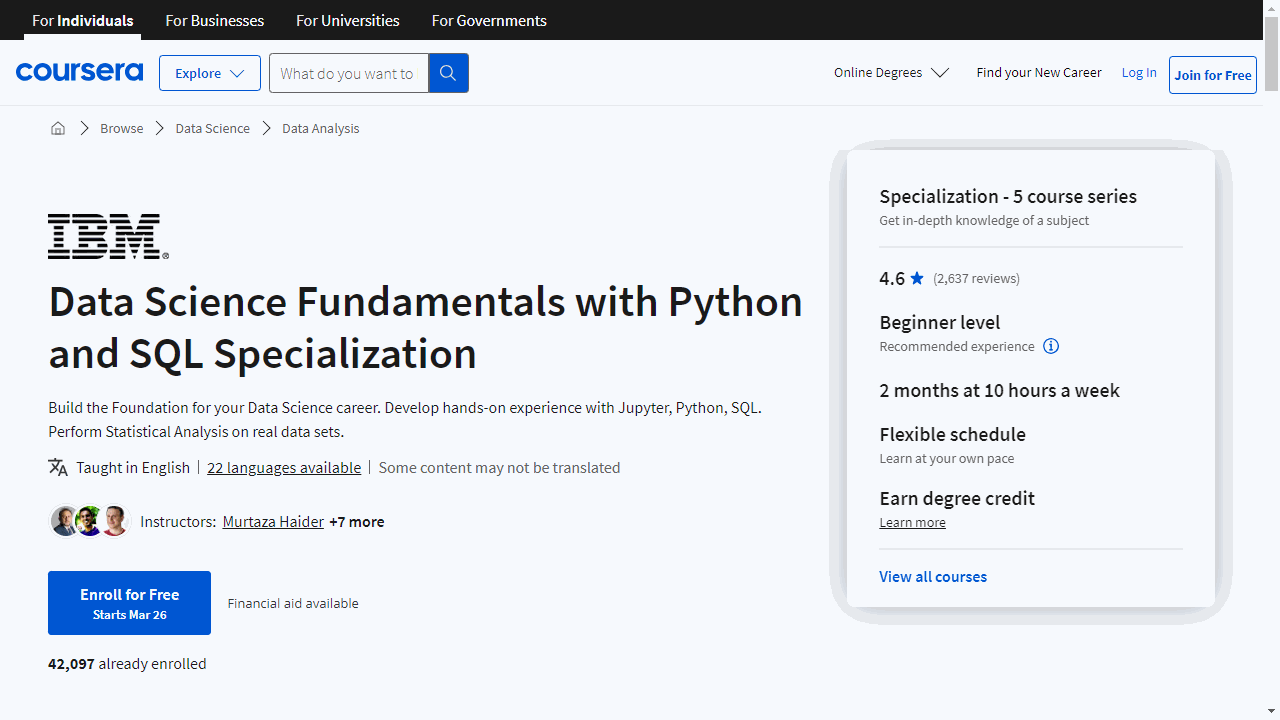Finding a great Python course on Coursera can be a real challenge with so many options out there.
You want something that’s comprehensive, engaging, and taught by experts, but you also want to make sure it fits your learning style and goals.
We’ve taken the time to explore the best Python courses on Coursera and have compiled our top picks.
For the best Python course overall, we recommend Python for Everybody Specialization.
This specialization is designed for beginners and gradually guides you from the basics of programming to more advanced topics like web data access and database interaction.
It’s highly regarded for its clear explanations, practical exercises, and real-world projects, making it a great choice for anyone looking to learn Python for personal or professional development.
Don’t worry if this particular course isn’t exactly what you’re looking for.
We have plenty of other options, including courses for beginners, intermediate learners, and experts, as well as specialized courses in data science, web development, and more.
Keep reading to discover the perfect Python course for you on Coursera.
Python for Everybody Specialization
You’ll start with the “Programming for Everybody” course, which teaches the basics of Python programming from the ground up.
No prior experience is required - you’ll learn how to write your first program, work with variables, functions, and loops.
It’s a gentle introduction to coding.
Next up is “Python Data Structures”, where you’ll dive into Python’s built-in data types like lists, dictionaries, and tuples.
You’ll learn how to store and manipulate complex data, a crucial skill for any programmer.
The third course, “Using Python to Access Web Data”, is where things get really interesting.
You’ll learn web scraping techniques to extract data from websites, as well as how to access APIs and work with formats like HTML, XML, and JSON.
This is invaluable for anyone working with data from the internet.
Then you’ll move on to “Using Databases with Python”, covering SQL and database design.
You’ll learn how to store and query data in databases like SQLite, a powerful tool for data analysis.
Plus, you’ll build web crawlers and do basic data visualization with D3.js.
Finally, the capstone project lets you put everything together.
You’ll retrieve, process, and visualize data of your choice using all the skills you’ve learned.
It’s the perfect way to solidify your Python knowledge.
Throughout the specialization, you’ll be using Python 3 and working with real-world examples.
The courses build on each other seamlessly, taking you from a complete beginner to someone who can wrangle data like a pro.
This specialization is offered by the University of Michigan.
Google IT Automation with Python Professional Certificate
This comprehensive program covers a wide range of topics, from the fundamentals of Python programming to advanced concepts like configuration management and cloud computing.
The journey begins with the “Crash Course on Python,” which introduces you to the basics of writing computer programs using Python.
You’ll learn about Python’s syntax, data structures like strings and lists, and how to create your own objects using Object-Oriented Programming (OOP) principles.
Even if you have no prior programming experience, this course will provide a solid foundation.
Next up is “Using Python to Interact with the Operating System,” where you’ll dive into manipulating files and processes on your computer’s operating system.
You’ll also explore powerful tools like regular expressions (regex) for processing text files and Bash scripting for automating tasks on Linux systems.
The “Introduction to Git and GitHub” course teaches you how to use the popular version control system Git to keep track of changes in your code and collaborate with others on GitHub.
This is an essential skill for any programmer or IT professional.
In “Troubleshooting and Debugging Techniques,” you’ll learn strategies for identifying and solving real-world problems in your code and IT infrastructure.
You’ll tackle issues related to speed, crashes, and resource exhaustion, as well as common pitfalls in your code.
The “Configuration Management and the Cloud” course introduces you to the concept of configuration management, which allows you to manage the configuration of multiple computers at scale using tools like Puppet.
You’ll also learn how to deploy and manage virtual machines in the cloud.
Finally, “Automating Real-World Tasks with Python” ties everything together.
You’ll learn how to use external Python modules like the Python Image Library (PIL) to extend your code’s capabilities.
You’ll also explore data serialization, which allows you to send messages between programs, and how to interact with web services using Application Programming Interfaces (APIs).
Throughout the program, you’ll work on hands-on projects and a capstone project, giving you practical experience in applying the concepts you’ve learned.
By the end, you’ll be well-equipped to tackle real-world automation tasks using Python.
Python 3 Programming Specialization
This specialization consists of five courses that will take you on a comprehensive journey through the fundamentals of Python programming.
The first course, Python Basics, is perfect for newcomers or those needing a refresher.
You’ll learn the basics of Python 3, including conditional statements, loops, and data structures like strings and lists.
You’ll even program an on-screen Turtle to draw pictures, developing practical programming and debugging skills along the way.
In the second course, Python Functions, Files, and Dictionaries, you’ll dive deeper into Python by exploring dictionaries, user-defined functions, local and global variables, and parameter-passing techniques like lambda expressions.
The final project involves reading simulated social media data from a file, computing sentiment scores, and writing out .csv files.
The third course, Data Collection and Processing with Python, teaches you to fetch and process data from Internet services.
You’ll master list comprehensions for data extraction and processing, and learn to interact with REST APIs using the requests library.
The final project is building a “tag recommender” for the Flickr photo sharing site.
Python Classes and Inheritance, the fourth course, introduces you to classes, instances, and inheritance – powerful concepts for representing data efficiently.
You’ll learn class design principles and the good habit of writing automated tests for your code.
Finally, the Python Project: pillow, tesseract, and opencv course walks you through a hands-on portfolio project.
You’ll manipulate images using the pillow library, apply optical character recognition (OCR) with tesseract, and identify faces in images using the open source opencv library.
Throughout the specialization, you’ll gain practical experience with Python programming, data structures, debugging, API interaction, and working with libraries like pillow, tesseract, and opencv.
The courses build upon each other, providing a solid foundation in Python while exposing you to real-world applications and techniques.
Introduction to Scripting in Python Specialization
This specialization is offered by Rice University.
The first course, Python Programming Essentials, introduces you to the fundamentals of programming using Python.
You’ll learn about expressions, variables, functions, logic, and conditionals - the building blocks of computer programming.
Additionally, you’ll gain experience working with Python modules, enabling you to leverage the language’s vast functionality.
By the end, you’ll be able to write short Python programs to accomplish practical tasks, setting the foundation for more complex projects.
In the second course, Python Data Representations, you’ll dive into different data representations like strings, lists, and tuples, which form the core of Python programs.
You’ll also learn how to access and manipulate files, allowing you to store and retrieve data within your programs.
This will enable you to write more sophisticated scripts that can handle various data formats.
The third course, Python Data Analysis, focuses on reading, storing, and processing tabular data, a common task in many applications.
You’ll learn about CSV files and how to read and write them using Python.
CSV files are a plain text file format that allows you to exchange tabular data between different programs, making your scripts more versatile.
The final course, Python Data Visualization, ties everything together.
You’ll learn how to install external Python packages, acquire data from web sources, clean and process it, and then analyze and visualize it.
This course will equip you with the skills to write practical, useful programs that can handle real-world data and generate insightful visualizations.
Throughout the specialization, you’ll work with Python 3, the future of the programming language, and gain experience with development environments like CodeSkulptor (a browser-based environment) and basic desktop environments.
This will prepare you for a wide range of Python programming tasks, from simple scripts to more complex data analysis and visualization projects.
Expressway to Data Science: Python Programming Specialization
This specialization is designed for beginners with little to no programming experience, guiding you through the fundamentals of Python step-by-step.
The first course, Introduction to Python Fundamentals, starts from the very basics.
You’ll learn how to use variables, operators, input/output, and flow control to build simple Python programs.
The pace is slow, allowing you to learn at your own speed and gain confidence with the language.
Once you’ve mastered the fundamentals, the second course, Introduction to Python Functions, teaches you how to use and define functions.
Functions are essential for creating reusable and adaptive programs, a crucial skill for any programmer.
With a solid foundation in Python, you’ll then dive into Python Packages for Data Science.
This course covers essential data science packages like Pandas, NumPy, Matplotlib, and Seaborn.
You’ll learn how to manipulate data using Pandas and NumPy, and create stunning data visualizations with Matplotlib and Seaborn.
Throughout the specialization, you’ll develop programming skills, gain experience with data science tools, and build a strong foundation in Python.
The courses are designed to be accessible, with clear explanations and hands-on exercises to reinforce your learning.
Statistics with Python Specialization
The first course, Understanding and Visualizing Data with Python, introduces you to the field of statistics.
You’ll learn about data sources, study designs, data management, and how to explore and visualize data using Python libraries like Numpy, Pandas, Matplotlib, and Seaborn.
You’ll gain skills in identifying different data types, creating visualizations, and understanding sampling techniques.
By the end, you’ll be able to communicate statistical ideas clearly and choose appropriate analytical techniques for probability and non-probability samples.
Next up is Inferential Statistical Analysis with Python, where you’ll dive into the principles of using data for estimation and theory assessment.
You’ll analyze categorical and quantitative data, construct confidence intervals, and assess whether a theory about a parameter is consistent with the data.
The course emphasizes interpreting inferential results correctly, and you’ll apply these concepts using Python, Statsmodels, Pandas, and Seaborn in the Jupyter Notebook environment.
The third course, Fitting Statistical Models to Data with Python, focuses on the art of fitting statistical models to data.
You’ll explore various modeling techniques like linear regression, logistic regression, generalized linear models, hierarchical/mixed effects models, and Bayesian inference.
The course emphasizes connecting research questions to data analysis methods, understanding relationships between variables, and making predictions.
You’ll work through case studies using real data sets and Python libraries like Statsmodels, Pandas, and Seaborn in the Jupyter Notebook environment.
Throughout the specialization, you’ll gain hands-on experience with Python and its powerful data analysis libraries.
You’ll learn to visualize and manage data, conduct statistical inference, fit statistical models, and interpret results.
Data Science Fundamentals with Python and SQL Specialization
This specialization, offered by IBM, covers a wide range of topics essential for anyone interested in data science, data analysis, or related fields.
The first course, “Tools for Data Science,” introduces you to the data scientist’s toolkit, including libraries, packages, datasets, machine learning models, and various open-source, commercial, and cloud-based tools.
You’ll gain hands-on experience with Jupyter Notebooks, JupyterLab, RStudio IDE, Git, GitHub, and Watson Studio, learning how to use these tools effectively.
Next, “Python for Data Science, AI & Development” teaches you Python from scratch.
You’ll learn Python basics, data types, data structures, logic concepts, and work with popular libraries like Pandas, NumPy, and Beautiful Soup.
This course equips you with the Python skills needed for data science, artificial intelligence, software development, and more.
The “Python Project for Data Science” course allows you to apply your Python knowledge to a real-world scenario.
You’ll play the role of a data scientist or data analyst, extracting data, web scraping, visualizing data, and creating a dashboard using Python, Pandas, Beautiful Soup, and Plotly within a Jupyter Notebook.
“Statistics for Data Science with Python” covers crucial statistical concepts like descriptive statistics, data visualization, hypothesis testing, ANOVA, regression, and correlation analysis.
You’ll learn to conduct statistical analyses using Python and Jupyter Notebooks, making it a practical course for data scientists and analysts.
Finally, “Databases and SQL for Data Science with Python” teaches you SQL, a must-have skill for data professionals.
You’ll learn to write SQL statements, create and manage databases, use advanced techniques like joins, views, and transactions, and integrate SQL with Python and Jupyter Notebooks.
Throughout the specialization, you’ll work with real-world datasets, complete hands-on projects, and gain practical experience using industry-standard tools like Jupyter Notebooks, Git, and cloud platforms.
Advanced Python Scripting for Cybersecurity Specialization
The first course, Advanced Python - Reconnaissance, teaches you how to use Python for automating reconnaissance on target environments.
You’ll learn techniques to automate password guessing attacks to gain initial access.
This lays the foundation for ethical hacking using Python scripting.
Next up is Establishing Command-and-Control and Finding Credentials.
Here, you’ll dive into using Python to set up command-and-control channels between the target system and the attacker’s infrastructure.
Additionally, you’ll learn how to collect sensitive information like user credentials from the compromised system using Python scripts.
The final course, Defensive Python, flips the perspective.
You’ll utilize Python for network analysis to detect and hijack suspicious connections, helping you understand defensive cybersecurity measures with Python scripting.
Throughout the specialization, you’ll get hands-on experience with using Python for reconnaissance, establishing backdoors, credential harvesting, and defensive network monitoring.
The courses strikes a balance between offensive and defensive cybersecurity techniques using Python as the core tool.
Programming in Python: A Hands-on Introduction Specialization
This specialization is designed for learners with little to no coding experience, providing a solid foundation in Python and core Computer Science concepts transferable to other languages.
The first course, Python Basics: Selection and Iteration, introduces you to printing, operators, loops (iteration), and conditionals (selection).
You’ll learn to use variables and operators to store and manipulate data, automate decision-making using selection statements, and repeat sections of your program using appropriate loop types.
The second course, Python Basic Structures: Lists, Strings, and Files, covers lists, strings, and file handling.
You’ll learn to store and manipulate lists of data, compare and manipulate strings of text, and read and write to text and CSV files.
In the third course, Python Object Basics: Functions, Recursion, and Objects, you’ll dive into functions, recursion, objects, and mutability.
You’ll define and use custom functions to improve code readability, learn when and how to use recursion instead of iteration, and create and modify custom objects.
The final course, Object-Oriented Python: Inheritance and Encapsulation, focuses on inheritance, encapsulation, polymorphism, and other object-oriented concepts.
You’ll learn to architect larger programs using object-oriented principles, reuse parts of classes using inheritance, and encapsulate relevant information and methods in a class.
These courses are video-free, offering a truly hands-on, self-paced learning experience.
Assignments include short explanations with images and runnable code examples, allowing you to explore and build a deeper understanding by doing.
You’ll receive instant feedback through various assessment items, progressing from quick understanding checks (multiple choice, fill in the blank, and unscrambling code blocks) to small, approachable coding exercises.
Applied Data Science with Python Specialization
You’ll start with the Introduction to Data Science in Python course, covering the basics of the Python programming environment, data manipulation with Pandas, and running statistical analyses.
You’ll learn techniques like working with CSV files, using NumPy, and understanding distributions and t-tests.
Next up is Applied Plotting, Charting & Data Representation in Python.
This course focuses on data visualization using Matplotlib.
You’ll learn best practices for creating effective charts and identifying the right visualization methods for your data.
The third course, Applied Machine Learning in Python, dives into machine learning techniques using scikit-learn.
You’ll learn how to cluster data, build predictive models, handle issues like overfitting, and engineer relevant features for your analysis needs.
If you’re interested in text data, Applied Text Mining in Python covers cleaning, processing, and analyzing text using NLTK and natural language processing methods like text classification and topic modeling.
Finally, Applied Social Network Analysis in Python uses the NetworkX library to represent and analyze network data.
You’ll explore concepts like network connectivity, node centrality, and predicting network evolution over time.
Throughout the specialization, you’ll gain hands-on experience with Python libraries like Pandas, NumPy, Matplotlib, scikit-learn, and NLTK.
The courses build on each other, so you can develop a comprehensive skillset in data science using Python.
Whether you want to visualize data, build machine learning models, analyze text, or study networks, this specialization has you covered.
Also check our posts on:


